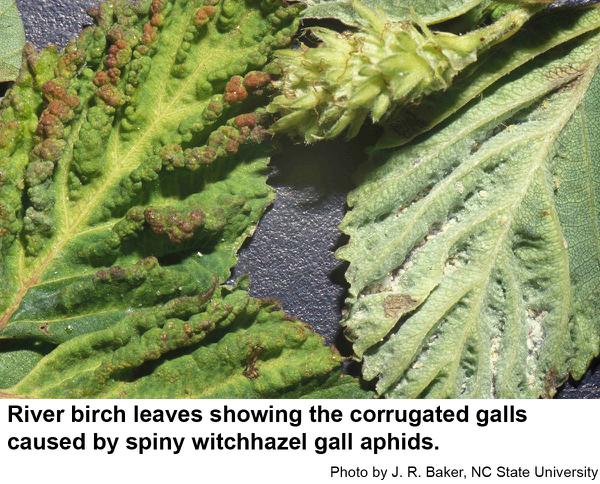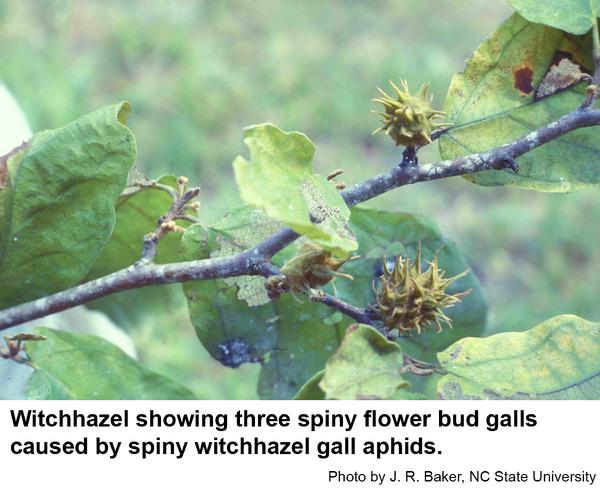Description and Biology
The spiny witchhazel gall aphid, Hamamelistes spinosus, is so called because it causes spiny galls on witchhazel. It is sometimes called the river birch aphid because it is most often noticed on river birch on which it causes bumpy ridges on the leaves. The overwintering eggs are laid in June and July on witchhazel. These eggs hatch the following spring and the new aphid nymphs crawl to the flower buds to feed (if the plant doesn't have flower buds, these aphids die!). Feeding on the flower buds induces the plant to form a spiny gall inside of which develop a second generation of winged aphids that eventually leave the galls and fly to birch. These winged aphids give birth to a scale-like generation which settles down and hibernates on birch until the following spring. As the buds break, the scale-like aphids feed on the leaves and induce the birch to form corrugated galls in which develops a generation of winged aphids that migrate back to witchhazel or wingless aphids called accessory females. The winged aphids that migrate back to witchhazel give birth to a generation of wingless males and females. These mate, and the females lay overwintering eggs. Special accessory females produce additional generations of winged aphids that migrate to witchhazel to give birth to males and females that lay additional overwintering eggs. Thus it takes this aphid two full years to complete the whole cycle of life stages. Alternation of hosts is well known for other aphids (woolly apple aphid: apple and elm; woolly alder aphid: maple and alder; green peach aphid: peach and many other hosts), but the spiny witchhazel gall aphid seems to have the most complicated life cycle.
Host Plants
Witchhazel and river birch are the only known hosts of the spiny witchhazel gall aphid. These aphids in the corrugated galls on birch are the most frequently noticed stage. River birch sheds most of its damaged leaves, and soon grows new leaves so no lasting harm is done to infested trees.
Residential Recommendations
On birches, imidacloprid or some other insecticide labeled for aphid management in the home landscape should be applied at bud break in early spring to prevent gall formation. This will have to be done every year until Gabriel blows his horn unless all of the witchhazels in the neighborhood can be found and eliminated (which might anger horticulturists who are nurturing 'Lady Diana' and other cultivars of witchhazel!). Insect populations may vary dramatically from year to year. Thus spiny witchhazel gall aphids may not be a problem at any one location for years at a time. The corrugated galls on birch are better thought of as cosmetic damage, since they cause no serious injury, and really do not require treatment.
References
- American Witchhazel (Hamamelis virginiana L.). Stritch, L. No Date. USDA Forest Service Plant of the Week.
- Aphids on Ornamental Landscape Plants. Steven Frank. 2009. Entomology Insect Notes, NC State Extension Publications.
- Extension Plant Pathology Publications and Factsheets
- Horticultural Science Publications
- North Carolina Agricultural Chemicals Manual
For assistance with a specific problem, contact your local N.C. Cooperative Extension Center.
This Factsheet has not been peer reviewed.
Publication date: Jan. 6, 2017
Reviewed/Revised: Oct. 15, 2019
Recommendations for the use of agricultural chemicals are included in this publication as a convenience to the reader. The use of brand names and any mention or listing of commercial products or services in this publication does not imply endorsement by NC State University or N.C. A&T State University nor discrimination against similar products or services not mentioned. Individuals who use agricultural chemicals are responsible for ensuring that the intended use complies with current regulations and conforms to the product label. Be sure to obtain current information about usage regulations and examine a current product label before applying any chemical. For assistance, contact your local N.C. Cooperative Extension county center.
N.C. Cooperative Extension prohibits discrimination and harassment regardless of age, color, disability, family and marital status, gender identity, national origin, political beliefs, race, religion, sex (including pregnancy), sexual orientation and veteran status.


